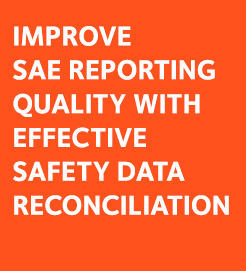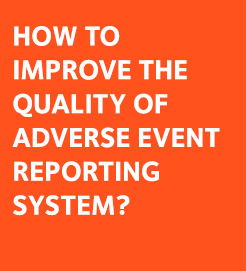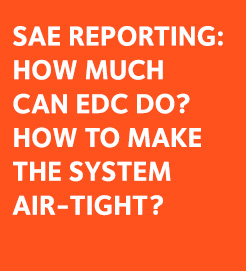Quality Investigational New Drug (IND) Safety Reports submitted to FDA enhance the safety of patients in clinical trial. While the FDA has set clear rules to ensure timely and accurate reporting of safety issues with the IND Safety Report, the sponsor-led SAE data reconciliation process further contributes to the solidity of the safety data submitted for the New Drug Application (NDA). A strong software tool for SAE data reconciliation provides sponsors with the best support for quality SAE assessment and reporting.
Why the IND Safety Report?
During the development of a new drug, sponsor companies collect a large amount of safety data starting with the pre-clinical investigations and extending into the “IND” (Investigational New Drug) phase of human trials. These data are used to build the safety profile of the new drug and will be referred to when the NDA (New Drug Application) is put together to support a request for marketing of the drug. However, because the development phase may last for many years and a number of subjects, either healthy or diseased, will be exposed to the investigational drug, health authorities have instituted continuous reporting systems in order to monitor and review all significant events as they occur during the development phases and be able to take prompt and appropriate action to protect the safety of participants in clinical trials. The FDA has put in place IND Safety Reporting and has communicated clear rules for the timely and accurate collection and transmission of adverse drug reactions during the development of new drugs (see below Box).
Strengthening the quality and accuracy of safety data through SAE data reconciliation
Although not all events are to be reported in an expedite manner, it is important that the information transmitted to the authorities is as complete and accurate as possible. Expedite reporting is performed based on the safety database information to comply with the stringent timelines but this information can be enriched or corrected with data from the clinical database.
Comparing the safety data collected in the safety database and that of the clinical database and reconciling the discrepant information strengthens the quality and accuracy of the data transmitted in the IND safety report, and ultimately contributes to the protection of subjects participating in clinical trials.
As the timing for IND Safety reporting is very tight, many individual reports are sent with incomplete and possibly erroneous information, at least in their initial version. Corrections can be done in subsequent submissions.
The role of an electronic SAE data reconciliation tool
A robust process of safety data reconciliation supported by the appropriate software tool that makes it easy to compare records from two distinct databases and resolve discrepancies provides the best guarantee of a prompt and accurate assessment of adverse events during a clinical trial, and allows for timely reporting of adverse reactions falling under the FDA guidance for IND safety reporting.
Issued in 2012, the guidance states the following:
Because it is critical that a drug product’s risks be adequately assessed during development, sponsors should ensure that they have in place a systematic approach for safety surveillance. In the framework of drug development, sponsors investigating a drug under an IND are required to notify FDA and all participating investigators, in a written IND safety report, of any adverse experience associated with the use of the drug that was both serious and unexpected, and any finding from tests in laboratory animals that suggested a significant risk for human subjects. The requirements distinguish circumstances in which it is appropriate to submit individual cases and circumstances in which cases should be aggregated and compared to cases in a control group and submitted only if the event occurs more frequently in the drug treatment group1.
The sponsor must report in an IND safety report any suspected adverse reaction to study treatment (i.e., including active comparators) that is both serious and unexpected. Before submitting an IND safety report, the sponsor needs to ensure that the event meets all three of the definitions:
• Suspected adverse reaction
• Serious
• Unexpected
Deciding whether the adverse event meets the definition of a suspected adverse reaction is usually the most difficult determination, but this decision is critical to avoid the submission of uninformative IND safety reports.
Under the guidance, the sponsor is required to notify FDA and all participating investigators in an IND safety report (i.e., 7- or 15-day expedited report) of potentially serious risks from clinical trials or any other source as soon as possible, but no later than 15 calendar days after the sponsor receives the safety information and determines that the information qualifies for reporting. Incomplete cases should be immediately followed up for additional information so that a determination can be made about whether the event is reportable as an IND safety report.
Under 21 CFR 312.321, the amended requirements make clear when to submit expedited safety reports. The requirements distinguish circumstances in which it is appropriate to submit individual cases and circumstances in which cases should be aggregated and compared to cases in a control group and submitted only if the event occurs more frequently in the drug treatment group.
A systematic approach for safety surveillance should include a process for reviewing, evaluating, and managing accumulating safety data from the entire clinical trial database at appropriate intervals. Sponsors should conduct ongoing safety evaluations, including periodic review and analyses of their entire safety database, not only for IND safety reporting purposes, but also to update investigator brochures, protocols, and consent forms with new safety information.
The IND safety reporting rule introduces terms and definitions that are meant to be clear and consistent.
A. Adverse Event
Adverse event means any untoward medical occurrence associated with the use of a drug in humans, whether or not considered drug related. An adverse event (also referred to as an adverse experience) can be any unfavourable and unintended sign (e.g., an abnormal laboratory finding), symptom, or disease temporally associated with the use of a drug, and does not imply any judgment about causality. An adverse event can arise with any use of the drug (e.g., off-label use, use in combination with another drug) and with any route of administration, formulation, or dose, including an overdose.
B. Suspected Adverse Reaction
Suspected adverse reaction means any adverse event for which there is a reasonable possibility that the drug caused the adverse event. For the purposes of IND safety reporting, ‘reasonable possibility’ means there is evidence to suggest a causal relationship between the drug and the adverse event. A suspected adverse reaction implies a lesser degree of certainty about causality than adverse reaction, which means any adverse event caused by a drug.
Suspected adverse reactions are the subset of all adverse events for which there is a reasonable possibility that the drug caused the event.
C. Adverse Reaction
An adverse reaction means any adverse event caused by a drug. Adverse reactions are a subset of all suspected adverse reactions where there is reason to conclude that the drug caused the event.
D. Unexpected
An adverse event or suspected adverse reaction is considered “unexpected” if it is not listed in the investigator brochure or is not listed at the specificity or severity that has been observed; or, if an investigator brochure is not required or available, is not consistent with the risk information described in the general investigational plan or elsewhere in the current application, as amended.
Adverse events listed in the investigator brochure as occurring with members of the same class of drugs, or as anticipated from the pharmacological properties of the drug, would be considered unexpected until they have been observed with the drug under investigation.
E. Serious
An adverse event or suspected adverse reaction is considered “serious” if, in the view of either the investigator or sponsor, it results in any of the following outcomes: Death, a life-threatening adverse event, inpatient hospitalization or prolongation of existing hospitalization, a persistent or significant incapacity or substantial disruption of the ability to conduct normal life functions, or a congenital anomaly/birth defect. Important medical events that may not result in death, be life-threatening, or require hospitalization may be considered serious when, based upon appropriate medical judgment, they may jeopardize the patient or subject and may require medical or surgical intervention to prevent one of the outcomes listed in this definition.
F. Life-Threatening
An adverse event or suspected adverse reaction is considered “life-threatening” if, in the view of either the investigator or sponsor, its occurrence places the patient or subject at immediate risk of death. It does not include an adverse event or suspected adverse reaction that, had it occurred in a more severe form, might have caused death.
_______________________
121 CFR § 312.32 - IND safety reporting
2Guidance for Industry and Investigators. Safety Reporting Requirements for INDs and BA/BE Studies
DOWNLOAD NOW THE FREE SAE RECONCILIATION HANDBOOK
The Manual / Reference Book with all the topics related to the Safety Data Reconciliation Management.







